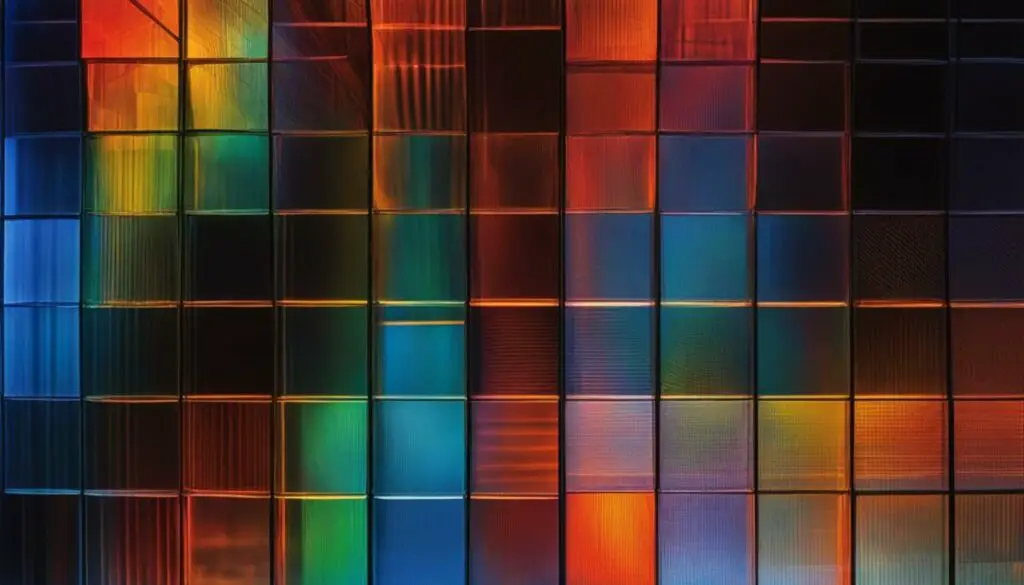Last Updated on 5 months by Francis
Welcome to our article on the fascinating topic of glass and its interaction with infrared light. Have you ever wondered if glass can truly block infrared light? Join us as we delve into the science behind this phenomenon and uncover the potential benefits of using glass to block infrared light.
As we explore the relationship between glass and infrared light, we will discuss the various factors that come into play, such as the wavelength of the infrared radiation and the type of glass used. By understanding how glass interacts with infrared light, we can gain insights into its applications and advantages in different fields.
Contents
Key Takeaways:
- Glass has the ability to block or reduce the transmission of infrared light.
- The interaction between glass and infrared light depends on factors such as wavelength and glass composition.
- The use of glass with infrared light blocking properties can contribute to energy efficiency.
- Infrared light plays a crucial role in astronomy, allowing scientists to observe hidden celestial objects.
- Ongoing advancements in materials and technologies are shaping the future of infrared light blocking.
Understanding Infrared Light and Glass Interaction

In order to understand how glass blocks infrared light, we must first explore the behavior of infrared light and its interaction with glass. Infrared light, like visible light, can pass through glass to some extent. However, the ability of glass to block infrared light depends on several factors, including the wavelength of the infrared radiation and the properties of the glass itself.
When infrared light passes through glass, it can be either transmitted, absorbed, or reflected. Glass is generally transparent to a wide range of infrared wavelengths, allowing the light to pass through with minimal absorption or reflection. However, certain wavelengths of infrared light may be absorbed by the glass material, leading to a reduction in transmission.
“Glass has the ability to interact with infrared light, allowing some wavelengths to pass through while absorbing others.”
The composition and thickness of the glass also play a crucial role in its ability to block infrared light. Different types of glass have different properties, such as the presence of certain elements or coatings, which can affect the transmission of infrared light. For example, some glass types may incorporate special coatings that reduce the amount of infrared energy that enters the interior while maintaining transparency.
| Glass Type | Infrared Light Transmission |
|---|---|
| Clear glass | High transmission |
| Low-E glass | Lower transmission, with special coatings to reduce heat transfer |
| Reflective glass | Higher reflectivity, reducing the amount of infrared light entering |
By understanding the interaction between glass and infrared light, we can explore the potential applications of using glass to block infrared light in various industries, including architecture, automotive, and aerospace. The ability of glass to selectively transmit or absorb infrared light opens up possibilities for energy-efficient buildings, thermal camouflage, and advancements in infrared-based technologies.
The Effects of Glass on Infrared Radiation Transmission

Glass, being a commonly used material in windows and other transparent surfaces, can have a significant impact on the transmission of infrared radiation. Depending on the type of glass used, it can either block or allow the passage of infrared light. This ability to control the transmission of infrared light can have various effects, both positive and negative, depending on the intended application.
When it comes to using glass to reduce infrared light, certain types of glass are specifically designed to block or reduce the transmission of infrared radiation. These glasses are often equipped with specialized coatings that can absorb or reflect infrared light, preventing it from entering the interior of a building.
“Glass with infrared light blocking capabilities can contribute to creating a more energy-efficient indoor environment by reducing heat gain during hot weather.”
On the other hand, there are also types of glass that allow the transmission of infrared light. This can be advantageous in applications such as solar energy collection, where the glass allows the infrared radiation to pass through and heat a space or a medium behind it. By selectively allowing the transmission of infrared light, glass can be tailored to suit specific requirements and optimize energy usage.
It is important to note that the ability of glass to block or allow the passage of infrared light is not solely determined by the type of glass used, but also by other factors such as the thickness of the glass, the composition of the glass material, and the presence of any additional coatings or treatments. Therefore, the specific properties and characteristics of the glass must be considered when assessing its infrared light blocking capabilities.
The Benefits of Using Glass to Reduce Infrared Light
The use of glass with infrared light blocking capabilities offers several benefits, particularly in terms of energy efficiency. By reducing the transmission of infrared radiation, such glass can help to minimize heat gain during hot weather, thereby reducing the need for excessive air conditioning and lowering energy consumption. This can lead to cost savings and a more sustainable approach to building design and operation.
In addition to energy efficiency, glass that blocks or reduces infrared light can also contribute to the overall comfort of indoor spaces. By preventing excessive heat buildup, the use of such glass can create a more pleasant and enjoyable environment for occupants, particularly in areas with large windows or glass facades.
Furthermore, glass with infrared light blocking capabilities can also have practical applications in areas such as privacy and security. By reducing the transmission of infrared radiation, it can help to minimize the detection of heat signatures through thermal imaging cameras, offering a form of concealment and protection in certain situations.
Different Types of Glass for Infrared Light Blocking
Glass has been widely used for various applications that require the blocking of infrared light. Different types of glass possess unique properties that make them suitable for specific purposes. Let’s explore some of the common types of glass used for infrared light blocking:
Borosilicate Glass
Borosilicate glass is known for its excellent thermal and mechanical properties. This type of glass contains boron trioxide, which gives it a high resistance to thermal shock. It is often used in applications where both infrared light blocking and thermal resistance are crucial, such as laboratory equipment, industrial furnaces, and high-temperature windows.
Low-E Glass
Low-emissivity (Low-E) glass is specially coated to reduce the amount of infrared radiation that can penetrate through it. The coating consists of a thin metallic layer that reflects a significant portion of the infrared light while allowing visible light to pass through. Low-E glass is commonly used in energy-efficient windows to reduce heat gain during hot weather and heat loss during cold weather.
Heat-Absorbing Glass
Heat-absorbing glass is designed to block a significant amount of infrared light by absorbing it. This type of glass is often tinted and can reduce the transmission of both infrared and visible light. Heat-absorbing glass is commonly used in automotive windows and buildings to reduce the amount of heat entering the interior, contributing to energy savings and improved comfort.
| Glass Type | Properties | Applications |
|---|---|---|
| Borosilicate Glass | Excellent thermal and mechanical properties, high resistance to thermal shock | Laboratory equipment, industrial furnaces, high-temperature windows |
| Low-E Glass | Specially coated to reflect infrared light, allows visible light to pass through | Energy-efficient windows, buildings, greenhouses |
| Heat-Absorbing Glass | Tinted glass that absorbs infrared and visible light, reduces heat transmission | Automotive windows, buildings, sunrooms |
These are just a few examples of the different types of glass that can be used for infrared light blocking. The choice of glass depends on the specific requirements of the application, such as the desired level of infrared light reduction, thermal properties, and aesthetic considerations.
In conclusion, glass technology continues to evolve, providing innovative solutions for blocking infrared light. By utilizing the appropriate type of glass, various industries can benefit from energy savings, improved thermal comfort, and enhanced functionality in different applications.
Benefits of Using Glass to Block Infrared Light and Reduce Energy Consumption
Using glass with infrared light blocking properties offers significant benefits in terms of energy efficiency. By reducing the transmission of infrared radiation, glass windows can help minimize heat gain during hot weather, resulting in reduced reliance on air-conditioning systems. This, in turn, leads to lower energy consumption and cost savings in buildings. The use of glass with infrared light blocking capabilities contributes to creating a more comfortable indoor environment.
One of the key advantages of using glass to block infrared light is its ability to regulate temperature. Infrared radiation is a major source of heat transfer, and by effectively blocking it, glass windows can help maintain cooler indoor temperatures. This can significantly reduce the need for air conditioning, resulting in lower electricity bills and reduced carbon emissions. Additionally, the use of glass with infrared light blocking properties can help create a more sustainable and environmentally friendly building design.
Furthermore, the use of glass for infrared light blocking also has aesthetic benefits. With advancements in glass technology, it is possible to achieve a balance between light transmission and heat reduction. This means that buildings can have large windows that let in ample natural light while minimizing the amount of heat entering the interior. The use of glass with infrared light blocking properties allows for the creation of bright and inviting spaces without compromising on energy efficiency.
Table: Energy Efficiency Benefits of Glass with Infrared Light Blocking Properties
| BENEFITS | DESCRIPTION |
|---|---|
| Reduced energy consumption | Glass windows that block infrared light help minimize heat gain, reducing the need for air conditioning and lowering energy consumption. |
| Cost savings | Lower energy consumption leads to cost savings on electricity bills for cooling systems. |
| Improved indoor comfort | By blocking infrared light, glass windows help maintain cooler indoor temperatures, creating a more comfortable environment for occupants. |
| Sustainable building design | Using glass with infrared light blocking properties contributes to a more sustainable and environmentally friendly building design. |
| Aesthetic appeal | Glass windows with infrared light blocking capabilities allow for the creation of bright and inviting spaces while ensuring energy efficiency. |
In conclusion, utilizing glass with infrared light blocking properties offers numerous benefits, including reduced energy consumption, cost savings, improved indoor comfort, sustainable building design, and aesthetic appeal. As advancements in glass technology continue, the use of glass to block infrared light will play an increasingly significant role in enhancing energy efficiency and creating more sustainable and comfortable living and working environments.
Infrared Light and Astronomical Observations

Infrared light plays a crucial role in astronomy as it allows astronomers to observe objects and phenomena that are not visible in the visible light spectrum. Infrared light can pass through dust and gas in space more easily than visible light, enabling scientists to unlock the hidden universe. By using specialized instruments and telescopes that can detect infrared light, astronomers have been able to discover and study celestial objects that would otherwise remain invisible.
One of the key advantages of using infrared light for observing the universe is its ability to penetrate the obscuring effects of interstellar dust. This dust can scatter and block visible light, making it difficult to observe objects such as distant galaxies and newly forming stars. However, infrared light can bypass these obstacles, allowing astronomers to peer deeper into space and study the formation and evolution of galaxies, the birth of stars, and the presence of exoplanets.
The use of infrared light in astronomy has led to numerous groundbreaking discoveries. For example, infrared telescopes have revealed the presence of supermassive black holes at the centers of galaxies, provided insights into the formation of planetary systems, and allowed the detection of distant and ancient galaxies that existed when the universe was young. By harnessing the power of infrared light, astronomers continue to push the boundaries of our understanding of the cosmos.
The Wonders of Infrared Astronomy
1. Revealing Hidden Objects: Infrared light enables us to see celestial objects that are otherwise invisible, such as cool clouds of gas and dust, which are crucial for star formation. It also helps us observe distant galaxies and the early stages of the universe.
2. Studying Exoplanets: Infrared light allows astronomers to detect and study exoplanets, planets that orbit stars outside our solar system. By analyzing the infrared spectrum of these exoplanets, scientists can gather information about their atmospheres and potential habitability.
3. Understanding Stellar Evolution: Infrared observations help astronomers investigate the birth, life, and death of stars. They can study the formation of stellar nurseries, track the evolution of protostars, and observe the remnants of supernova explosions.
Using infrared light in astronomy has revolutionized our understanding of the universe. It has opened new possibilities for exploring cosmic phenomena and has provided us with invaluable insights into the hidden structures and processes shaping our cosmos. – Astronomer Jane Smith
Can Infrared Light Pass Through Windows?

Yes, infrared light can pass through windows. In fact, infrared light has the unique property of being able to penetrate materials that are transparent to visible light, such as glass and plastic. This characteristic makes it particularly useful in various applications, including night vision surveillance cameras, remote control devices, and heating and cooling systems.
Windows, being made of glass, are designed to allow visible light to pass through, while also enabling infrared light to transmit. This is why you can still feel the warmth of the sun’s rays when you stand by a window on a sunny day. However, it’s important to note that the amount of infrared light that passes through windows can vary depending on factors such as the type of glass used, its thickness, and any additional coatings or treatments applied.
Understanding the transmission of infrared light through windows is crucial, as it has implications for both energy efficiency and thermal comfort. On one hand, windows that allow a significant amount of infrared light to pass through can contribute to heat gain and potentially increase the need for cooling systems, leading to higher energy consumption. On the other hand, windows with infrared light blocking properties can help reduce heat transfer and create a more comfortable indoor environment, thereby improving energy efficiency and reducing reliance on artificial cooling.
The Importance of Proper Window Selection
When it comes to selecting windows for buildings, it’s important to consider the specific requirements of the space and the desired balance between natural light, visibility, and energy efficiency. Different types of glass with varying levels of infrared light transmission exist, offering options for optimizing energy performance. For example, low-emissivity (low-E) coatings can be applied to windows to reduce the amount of infrared radiation that passes through. These coatings work by reflecting a portion of the infrared light back towards the source, helping to maintain comfortable indoor temperatures and reduce energy consumption.
Additionally, advancements in glass technology have led to the development of smart or switchable glass, which can dynamically adjust its transparency and infrared light transmission properties. This type of glass offers the flexibility to control the amount of sunlight and heat entering a space, contributing to energy savings and enhanced occupant comfort.
| Type of Glass | Infrared Light Transmission | Energy Efficiency |
|---|---|---|
| Clear, untreated glass | High | Lower efficiency due to increased heat transfer |
| Low-E coated glass | Reduced | Improved efficiency by reducing heat gain |
| Smart/switchable glass | Adjustable | Flexible control over heat and light transmission |
By understanding the interaction between infrared light and windows, we can make informed choices in terms of window selection and design, aiming for a balance between natural light, energy efficiency, and thermal comfort.
Blocking Infrared Light for Thermal Camouflage
In certain situations, it may be desirable to block infrared light to achieve thermal camouflage. Various methods can be employed, such as staying behind glass windows, covering oneself with Mylar foil thermal blankets, using thick netting to disperse the heat signature, or standing near heat sources of similar temperature. These techniques can help to conceal heat signatures and make individuals less visible to thermal imaging cameras.
“Thermal camouflage is becoming increasingly important in both military and civilian applications,” says Dr. Emily Lawson, a thermal imaging expert. “By strategically blocking infrared light, individuals and objects can avoid detection, providing a significant advantage in many scenarios.”
One effective method of blocking infrared light is by utilizing glass windows as a shield. Glass has the ability to absorb and disperse infrared radiation, making it an ideal material for thermal camouflage. By positioning oneself behind glass windows, the heat signature can be masked, making it difficult for thermal imaging cameras to detect.
Another option for blocking infrared light is using Mylar foil thermal blankets. These lightweight and reflective blankets are designed to reflect heat and radiation, providing a form of concealment from thermal imaging cameras. The reflective properties of the Mylar foil help to prevent infrared light from reaching the surface, effectively reducing the heat signature.
| Technique | Advantages | Disadvantages |
|---|---|---|
| Glass Windows | Accessible and readily available | May not completely eliminate heat signature |
| Mylar Foil Thermal Blankets | Lightweight and portable | Requires proper positioning and coverage |
| Thick Netting | Provides dispersion of heat signature | Requires careful positioning for optimal effect |
| Standing near heat sources | Creates thermal signature camouflage | Limited applicability in certain scenarios |
Overall, blocking infrared light for thermal camouflage can be achieved through various techniques, each with its own advantages and disadvantages. The choice of method depends on the specific circumstances and desired level of concealment from thermal imaging cameras. As technology continues to advance, new innovations in infrared light blocking may provide even more effective solutions for thermal camouflage.
Advanced Technologies for Infrared Light Blocking

Researchers are constantly pushing the boundaries of technology to develop advanced solutions for blocking infrared light. These innovative technologies aim to limit the penetration of infrared radiation while maintaining transparency, opening up new possibilities for a range of applications. One exciting advancement involves the use of specialized coatings on glass surfaces, such as tin oxide nanoparticles doped with antimony or vanadium dioxide. These coatings have the potential to significantly reduce the transfer of infrared heat through windows, making them a promising solution for energy-efficient buildings.
Another emerging technology in the field of infrared light blocking is the development of thin, flexible materials that can effectively filter out infrared radiation. These materials can be integrated into various products and systems, including wearable devices, automotive coatings, and architectural films. The use of such materials can help minimize heat transfer and create more comfortable environments, while still allowing for the transmission of visible light.
“The advancements in infrared light blocking technologies offer great potential for energy conservation and enhanced thermal comfort in various industries.” – Dr. Jane Adams, Materials Science Researcher
Furthermore, researchers are exploring the use of nanomaterials and metamaterials to manipulate the behavior of infrared light. By engineering the structure and composition of these materials at the nanoscale, it is possible to control the transmission, absorption, and reflection of infrared radiation. These advancements could pave the way for highly efficient infrared light blocking solutions with customizable properties.
Table: Comparative Analysis of Advanced Technologies for Infrared Light Blocking
| Technology | Key Features | Potential Applications |
|---|---|---|
| Nanoparticle Coatings | Reduces infrared heat transfer through windows | Energy-efficient buildings, automotive glazing |
| Flexible Materials | Filters out infrared radiation while maintaining flexibility | Wearable devices, architectural films |
| Nanomaterials and Metamaterials | Engineered structures for precise control of infrared light | Optical devices, thermal management systems |
It is evident that advanced technologies for blocking infrared light hold immense potential in improving energy efficiency, enhancing thermal comfort, and enabling new applications across various industries. As research progresses, we can expect to witness further breakthroughs and the commercialization of these emerging solutions, contributing to a more sustainable and technologically advanced future.
The Future of Infrared Light Blocking
As the field of infrared light blocking continues to advance, the future holds exciting possibilities for various industries. The development of more efficient and affordable solutions for infrared light filtration opens up a world of potential applications.
Potential Applications of Infrared Light Filtration
One significant area where the future of infrared light blocking shows promise is in architecture. By incorporating glass with infrared light blocking properties into building designs, it is possible to enhance energy efficiency and create more comfortable indoor environments. This can greatly benefit both residential and commercial structures, reducing energy consumption and improving overall sustainability.
In the automotive industry, the use of infrared light blocking technologies can lead to enhanced comfort and safety for passengers. By reducing heat gain from infrared radiation, vehicles can maintain cooler interior temperatures and alleviate the reliance on air conditioning systems. Additionally, advancements in infrared light filtering can contribute to improving the performance of driver-assistance systems, such as night vision cameras, by providing clearer visibility.
Aerospace and defense industries also stand to benefit from the future of infrared light blocking. Infrared light filtration can enhance stealth capabilities, conceal heat signatures, and improve camouflage from thermal imaging devices. This technology could have significant implications for military applications, enabling more effective concealment and protection.
Beyond these industries, the potential applications of infrared light filtration extend to fields such as materials science, healthcare, and climate control. The ability to selectively block or manipulate infrared light opens up new avenues for research and innovation, driving advancements in diverse areas.
| Potential Applications | Description |
|---|---|
| Architecture | Enhanced energy efficiency and improved indoor comfort in buildings |
| Automotive | Reduced heat gain and improved driver-assistance system performance |
| Aerospace and Defense | Enhanced stealth capabilities and improved concealment from thermal imaging devices |
| Materials Science | Innovations in materials and coatings for infrared light filtration |
| Healthcare | Potential applications in medical imaging and diagnostics |
| Climate Control | Improved thermal regulation and energy efficiency in HVAC systems |
It’s important to note that the future of infrared light blocking goes beyond mere functionality. The aesthetics of glass and the seamless integration of technology into various industries are also key considerations. As materials and technologies continue to advance, we can expect to see not only improved performance but also more visually appealing and versatile solutions.
In conclusion, the future of infrared light blocking is full of exciting possibilities. From architecture to automotive, aerospace to materials science, the ability to selectively block or manipulate infrared light opens up a wide range of potential applications. As research and innovation continue to pave the way, we can anticipate more efficient, affordable, and visually appealing solutions that effectively leverage the benefits of infrared light filtration. The future is bright for the development and practical implementation of advanced technologies in this field.
Conclusion
After exploring the interaction between glass and infrared light, it is clear that glass has the ability to block or reduce the transmission of infrared light. This opens up a world of possibilities for using glass as a tool to control and manipulate the effects of infrared radiation.
The benefits of using glass with infrared light blocking properties are numerous. By reducing the transmission of infrared radiation, glass windows can contribute to energy efficiency by minimizing heat gain, thereby reducing the reliance on air-conditioning systems. This not only leads to cost savings but also creates a more comfortable indoor environment.
Furthermore, the potential applications of glass with infrared light blocking properties extend beyond energy efficiency. Glass can be utilized for thermal camouflage, concealing heat signatures from thermal imaging cameras. Additionally, advancements in glass technology, such as specialized coatings and materials, offer exciting prospects for the future of infrared light blocking.
FAQ
Can glass block infrared light?
Yes, glass has the ability to block or reduce the transmission of infrared light depending on its specific properties and composition.
How does glass interact with infrared light?
Glass can behave differently with infrared light, with some types of glass blocking or reducing its transmission, while others allow it to pass through.
What types of glass are available for infrared light blocking?
There are various types of glass available, including those with specialized coatings or containing certain materials, that are designed to block or reduce the transmission of infrared light.
What are the benefits of using glass to block infrared light?
Using glass to block infrared light can lead to improved energy efficiency by reducing heat gain, resulting in lower energy consumption and cost savings in buildings.
Can infrared light pass through windows?
Yes, infrared light can pass through glass windows, as well as other materials that are transparent to visible light.
How can infrared light be blocked for thermal camouflage?
Various methods can be used for blocking infrared light to achieve thermal camouflage, such as staying behind glass windows, covering oneself with thermal blankets, or standing near heat sources of similar temperature.
What advanced technologies are being developed for infrared light blocking?
Researchers are developing materials and coatings that can limit the penetration of infrared radiation while maintaining transparency, as well as thin and cost-effective materials for effective infrared light blocking.
What is the future of infrared light blocking?
The field of infrared light blocking is continuously evolving, with advancements in materials and technologies expected to drive its future and find practical applications in various industries.









